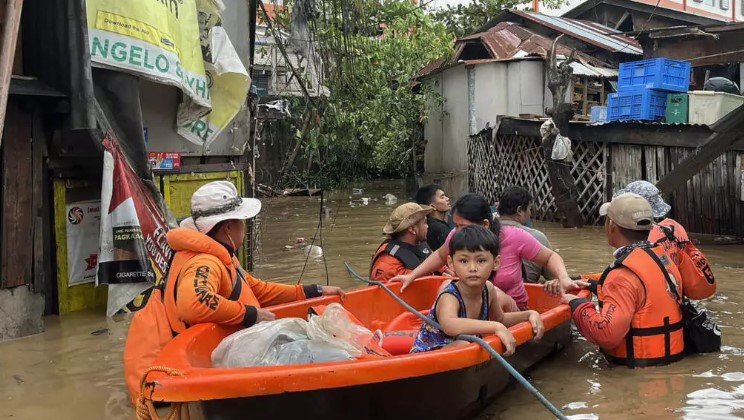
SATV Kathmandu Noc 05: At least 52 people have lost their lives and hundreds of thousands have fled their homes after one of the strongest typhoons of the year tore through the central Philippines, the BBC reported.
Typhoon Kalmaegi caused widespread flooding, submerging entire towns across Cebu, the country’s most populated central island, where most deaths occurred. Thirteen people are still missing. Videos showed residents seeking refuge on rooftops as cars and shipping containers were swept through the streets, according to the BBC.
The official toll does not include six crew members of a military helicopter that crashed on Mindanao island while responding to the disaster. The aircraft went down near Agusan del Sur after losing contact during relief operations. A search mission later recovered six bodies, believed to be those of the pilot and crew, the BBC reported.
Locally called Tino, the storm weakened after making landfall early Tuesday but continued to bring winds exceeding 80 miles (130 kilometers) per hour. Weather agencies expect it to move across the Visayas islands before heading out over the South China Sea by Wednesday, added the BBC.
Cebu Governor Pamela Baricuatro called the situation “unprecedented,” saying authorities had expected the winds to be the biggest threat, but the flooding proved far worse. Declaring a state of calamity on Tuesday night, she said floodwaters had devastated entire communities, the BBC said.
Reports suggest most victims drowned as torrents of mud and water swept down from hillsides into towns and cities. Homes were destroyed, smaller buildings washed away, and streets were covered in thick mud. Rescue teams used boats to reach people trapped inside their houses, the BBC noted.
In Cebu City, Don del Rosario, 28, said he had never witnessed such a severe storm. “I’ve been here for 28 years, and this is by far the worst we’ve experienced,” he told AFP. Officials said nearly 400,000 people had been relocated from the typhoon’s path, according to Rafaelito Alejandro from the Office of Civil Defence, the BBC mentioned.
The Philippines is hit by around 20 typhoons every year. Kalmaegi arrived just weeks after two earlier storms killed over a dozen people and damaged infrastructure and crops. Super Typhoon Ragasa, known locally as Nando, struck in late September, followed closely by Typhoon Bualoi, called Opong locally, the BBC stated.
Earlier this year, heavy monsoon rains triggered massive flooding and public outrage over unfinished and poor-quality flood control projects blamed on corruption. On September 30, a 6.9 magnitude earthquake hit central Philippines, killing and injuring dozens, with Cebu suffering the worst damage, according to the BBC.
Typhoon Kalmaegi is expected to move toward Vietnam next, which is already dealing with record-breaking rainfall.



















